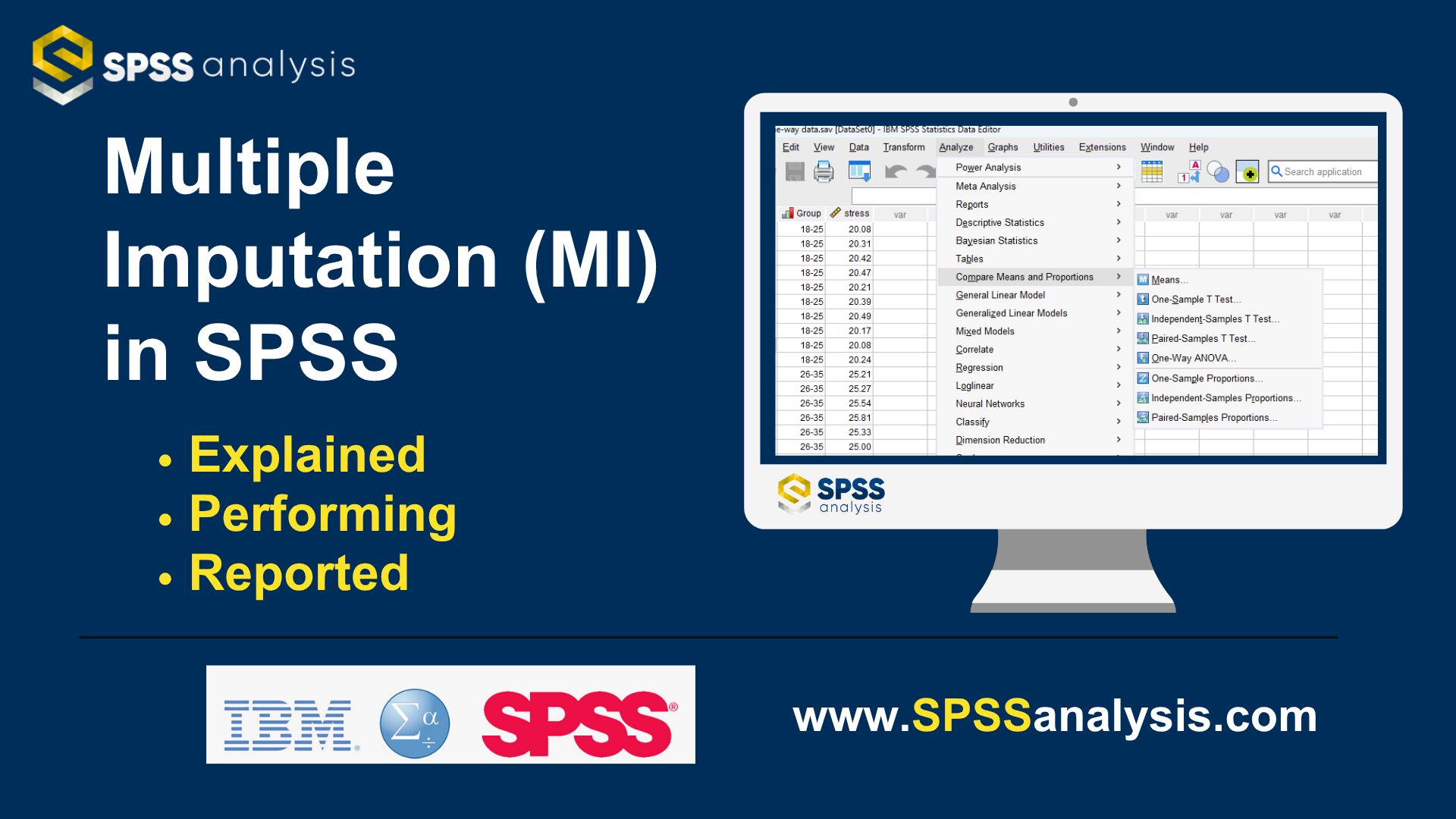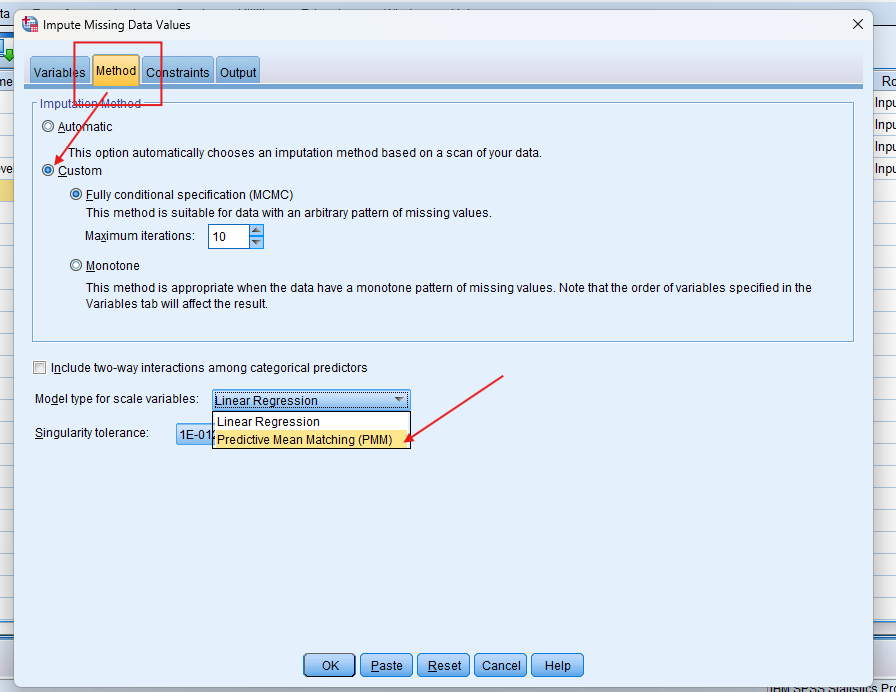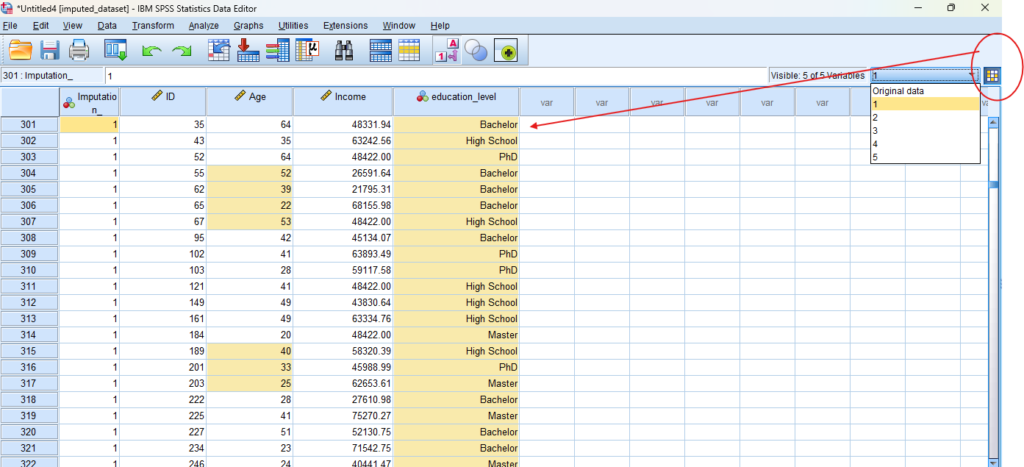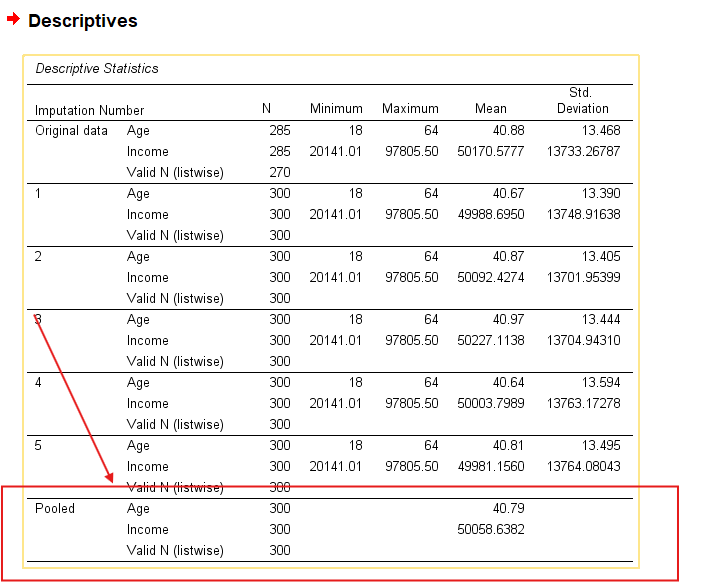Multiple Imputation in SPSS
Discover Multiple Imputation in SPSS! Learn how to perform, understand SPSS output, and report results in APA style. Check out this simple, easy-to-follow guide below for a quick read!
Struggling with Multiple Imputation in SPSS! We’re here to help. We provide comprehensive support to academics and PhD students, encompassing assignments, dissertations, research, and additional services. Request Quote Now!
1. Introduction
Handling missing data is essential in statistical analysis to avoid biased results and invalid conclusions. Among the many techniques available, multiple imputation stands out for its ability to address missingness while preserving the integrity of the data structure. In SPSS, multiple imputation can be implemented efficiently using a range of flexible options. This guide explains how MI works in SPSS, when to use it, and how to interpret the results.
2. What is Missing Data?
Missing data refers to the absence of information for one or more variables in a dataset. It can occur randomly or follow patterns, and it can be classified into three categories:
MCAR (Missing Completely at Random): The probability of missingness is unrelated to any observed or unobserved data.
MAR (Missing at Random): Missingness depends on other observed variables.
MNAR (Missing Not at Random): Missingness depends on the value itself or unobserved data.
Understanding the type of missingness is crucial for selecting an appropriate imputation strategy.
3. How to Handle Missing Data in SPSS
SPSS offers a variety of tools to address missing data, grouped into two main categories: single imputation and multiple imputation. Choosing the right approach depends on the amount of missingness, the underlying missing data mechanism (MCAR, MAR, MNAR), and the analysis goals.
I. Single Imputation Methods (via “Replace Missing Values” in SPSS)
These techniques substitute each missing value with a single estimate based on existing data:
Series Mean: Replaces all missing values in a variable with the overall mean of that variable. Best for normally distributed variables with low missingness.
Mean of Nearby Points: Uses the mean of adjacent (neighboring) values, which can be useful for time-series or ordered data.
Median of Nearby Points: Similar to the above, but uses the median instead of the mean, making it more robust to outliers.
Linear Interpolation: Fills in missing values using a straight line between two known data points. Works well when values are missing in the middle of a sequence.
Linear Trend at Point: Applies a linear regression model to predict the missing value at a specific point based on the trend of the variable across time or order.
These methods are quick and easy to implement, but they do not reflect uncertainty, and may bias standard errors or reduce variability in your dataset.
II. Multiple Imputation Methods (via “Multiple Imputation” in SPSS)
Unlike single imputation, multiple imputation creates several different plausible values for each missing data point, generating multiple complete datasets. The results from these datasets are then pooled for final analysis, allowing better estimation of uncertainty due to missing data. SPSS uses the MCMC and FCS (Fully Conditional Specification) frameworks to perform multiple imputation.
Here are the common methods:
FCS / MICE (Multiple Imputation by Chained Equations): This is the default in SPSS. Each variable with missing data is imputed conditionally based on a regression model using the other variables. This is flexible and supports both continuous and categorical data.
Best when data are Missing at Random (MAR) and the relationships among variables are important to preserve.
Predictive Mean Matching (PMM): A variation of regression imputation that ensures the imputed value is a realistic value from the observed dataset. It selects an observed value from cases with similar predicted values.
Useful when you want to avoid unrealistic or out-of-range imputed values
Linear Regression Imputation (LRI): Assumes normally distributed residuals; sensitive to outliers.
Both methods are accessible via
Analyze → Multiple Imputation → Impute Missing Data Values, and can be specified under the Method section of the imputation model.
Bayesian Estimation: Introduces randomness by sampling from a posterior distribution of parameters. This allows the imputations to reflect both model uncertainty and missingness.
Suitable for advanced users working under MAR assumptions or when modeling uncertainty is critical.
Multiple imputation is recommended when:
More than 5–10% of the data are missing
You assume data are MAR
You need valid inferences for regression, hypothesis testing, or model building
While more computationally intensive, multiple imputation provides more accurate standard errors and better preserves data relationships compared to single imputation.
Comparing: Single vs Multiple Imputation
| Feature | Single Imputation | Multiple Imputation |
|---|---|---|
| Number of datasets | One | Multiple (e.g., 5–20+) |
| Uncertainty accounted for | No | Yes |
| Standard error estimation | Underestimated | Properly estimated |
| Risk of bias | Higher | Lower (especially if MAR holds) |
| Common methods | Mean, Median, LOCF, Regression | MICE (FCS), PMM, Bayesian |
| Output | One filled dataset | Several filled + pooled results |
4. How MICE Mechanism Works for Multiple Imputation
The MICE (Multivariate Imputation by Chained Equations) algorithm, also known in SPSS as Fully Conditional Specification (FCS), works by:
Cycling through each variable with missing values one at a time
Imputing that variable using a regression model based on all other variables
Updating the dataset with the new imputed values
Repeating this process for multiple iterations to stabilize the imputations
Creating multiple versions of the completed dataset by repeating the cycle
This method is flexible and supports both continuous and categorical variables, as well as nonlinear relationships.
5. Rubin’s Rule for Multiple Imputation
Multiple Imputation (MI) is a technique that:
Replaces missing values multiple times to create multiple complete datasets.
Analyzes each dataset separately.
Combines estimates using Rubin’s rules for valid inference.
MI helps capture the uncertainty associated with missing data and produces more accurate standard errors and confidence intervals than single imputation.
Rubin’s Rule is a statistical method used to combine results from multiple imputed datasets. After missing data are filled in using multiple imputation, each dataset is analyzed separately. Rubin’s Rule then pools these results to produce a single, valid estimate that accounts for both:
Within-imputation variance (variability inside each dataset), and
Between-imputation variance (variability across the imputed datasets).
This rule ensures that standard errors, confidence intervals, and p-values properly reflect the uncertainty caused by missing data. SPSS automatically applies Rubin’s Rule when pooling estimates, allowing researchers to draw statistically sound inferences from multiply imputed data.
6. Why Handling Missing Values Is Important in Statistical Analysis?
Failing to address missing data properly can lead to:
Biased estimates: If missingness is not random, ignoring it can distort your results.
Reduced statistical power: Loss of data means less information, resulting in wider confidence intervals and weaker significance.
Invalid assumptions: Many statistical models assume complete data. Violating this can compromise model validity.
By handling missing data thoughtfully—starting with an appropriate imputation strategy—you can ensure more reliable and interpretable results.
7. Why Multiple Imputation is Critical for Statistical Analysis?
Multiple imputation offers several advantages that make it essential for robust analysis:
Reduces bias by modeling missingness appropriately
Increases statistical power by retaining all cases
Reflects uncertainty due to missing data
Improves generalizability of results
Recommended by major journals and statistical guidelines
Handles complex missing data patterns (e.g., MAR, MCAR)
8. How Much Imputed Data Should Be?
The number of imputations depends on the extent of missing data and the complexity of the model. Here are general guidelines:
For small datasets or minimal missingness: 5–10 imputations may be sufficient
For moderate to high missingness: 20–40 imputations recommended
Some studies suggest that more imputations improve the precision of pooled estimates, especially for hypothesis testing and confidence intervals
9. An Example for Multiple Imputation
Suppose you have a dataset with 300 observations, but 15 values are missing in both Age and Income, and 30 values are missing in education_level. Using SPSS, you can run multiple imputation with the Fully Conditional Specification (FCS) method using Predictive Mean Matching or Linear Regression. After five imputations, SPSS generates five completed datasets which can be analyzed and pooled.
In the following section, you can find how to perform multiple imputation using Predictive Mean Matching (PMM). If you would like to learn how to perform Linear Regression Imputation in SPSS, please visit the following page: Linear Regression Imputation in SPSS.
10. How to Perform Multiple Imputation in SPSS
Step by Step: Running Multiple Imputation in SPSS Statistics
To apply Multiple Imputation (MI) in SPSS:
Go to
Analyze → Multiple Imputation → Impute Missing Data Values.Variables Tab:
Add variables with missing values to the Impute box.
Add predictors to the Predictors box.
Set a name for the imputed datasets (e.g.,
imp_).
Method Tab:
Choose Fully Conditional Specification (FCS).
For each scale variable, select PMM as the imputation method.
Constraints Tab:
Set roles as needed: Impute only, Use as predictor, or Impute and use as predictor.
Output Tab:
Tick both options to display summaries and iteration history.
Set the number of imputations (e.g., 5) and iterations (e.g., 10), then click OK.
SPSS will create the imputed datasets, which can be viewed and analyzed using pooled results.
11. SPSS Output for Multiple Imputation using PMM
12. How to Interpret SPSS Output for Multiple Imputation
Once the imputation is complete, SPSS provides several key outputs:
Imputation Summary Table: Shows which variables were imputed, how many values were missing, and the method used (e.g., PMM).
Iteration History Table: Displays changes in variable means over the 10 iterations, confirming convergence.
Descriptive Statistics Table: Reports the mean and standard deviation for each imputed variable across the datasets.
Imputed Dataset Viewer: You can review each imputed dataset individually via the drop-down in the SPSS Data Editor.
Pooled Results via Descriptives: After imputation, use
Analyze → Descriptive Statistics → Descriptives, check the “Pool results across imputations” box to obtain pooled means, standard deviations, or frequencies.
This allows the user to evaluate the plausibility and stability of the imputations, and confirms consistency across imputed datasets.
13. How to Report Multiple Imputation
When reporting Predictive Mean Matching, include:
The software and method used (e.g., PMM under FCS in SPSS).
The number of imputations and iterations performed.
Key assumptions (e.g., data assumed to be MAR).
Pooled descriptive statistics (e.g., mean, SD).
The rationale for using PMM over alternatives.
Clarify that results were pooled using Rubin’s rules.
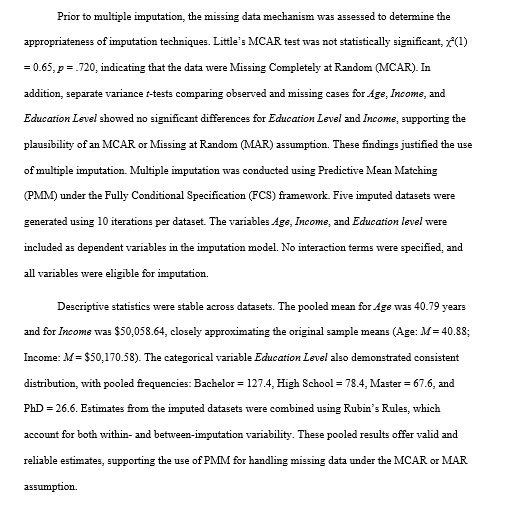
Get Help For Your SPSS Analysis
Embark on a seamless research journey with SPSSAnalysis.com, where our dedicated team provides expert data analysis assistance for students, academicians, and individuals. We ensure your research is elevated with precision. Explore our pages;
- SPSS Help by Subjects Area: Psychology, Sociology, Nursing, Education, Medical, Healthcare, Epidemiology, Marketing
- Dissertation Methodology Help
- Dissertation Data Analysis Help
- Dissertation Results Help
- Pay Someone to Do My Data Analysis
- Hire a Statistician for Dissertation
- Statistics Help for DNP Dissertation
- Pay Someone to Do My Dissertation Statistics
Connect with us at SPSSAnalysis.com to empower your research endeavors and achieve impactful data analysis results. Get a FREE Quote Today!
Note
Conducting PMM in SPSS provides a robust foundation for understanding the key features of your data. Always ensure that you consult the documentation corresponding to your SPSS version, as steps might slightly differ based on the software version in use.
This guide is tailored for SPSS version 25, and for any variations, it’s recommended to refer to the software’s documentation for accurate and updated instructions.


